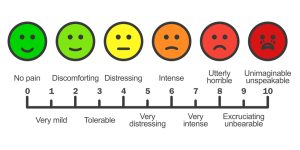
Describing pain to someone who doesn’t experience the same thing can be tricky, but there are some things to keep in mind in the process. Continue reading for tips on how to describe back pain to your doctor.
Back pain and neck pain are subjective. Few, if any, definitive tests exist that can accurately measure and diagnose the experience. And pain levels fluctuate, in terms of timing, intensity, and quality, which make it nearly impossible to use objective testing methods such as an MRI or CT scan to get a true picture of what you experience on a day to day basis.
Just the same, a big responsibility you have in the quest for the right treatment is to clearly describe your back pain to your healthcare provider. Sometimes that can be an art form in itself.
To prepare for that all-important conversation with your healthcare provider, you might consider keeping a pain journal for a few weeks leading up to your appointment. In fact, many people who live with persistent pain are long-term committed journal keepers. For them, a pain journal is a necessary element of their pain management program.
Below are some of the bits of information healthcare providers try to elicit from their pain patients during the medical history portion of the diagnostic process.
Note the Intensity of Your Pain
How bad does it hurt? Knowing this is one of the first steps to working collaboratively with your healthcare provider. Intensity is a measure of the strength of felt pain signals.
As the patient, this is probably the most important part of the ordeal for you. Many healthcare providers will ask you to fill out a visual chart of some sort. You may be asked to rate the intensity of your pain with a number, or by picking a “face” that represents how the pain makes you feel; this is called the “oucher” or “faces” chart. The “faces” in the oucher chart go from happy and smiling to crying.
Use Words that Describe the Pain
The quality of your pain may mean something about what’s causing it. For example, if you experience burning, stabbing or electrical sensations down one leg or arm, it may indicate a compressed or irritated spinal nerve root (which is called radiculopathy).
If you can expand the pain vocabulary you use in your journal, you may find communicating with your healthcare provider is easier and more fruitful for you.
The McGill Pain Questionnaire from McGill University in Canada provides a series of descriptive words that some healthcare providers will use to try to get an insight into your pain, whether during the initial diagnostic process or at the follow-up and monitoring experiences.3 The words are categorized according to 3 questions that may help you describe the pain. They are:
- What does your pain feel like? Expanding your existing vocabulary with more descriptive words may come in handy here.
- How does your pain change with time? Example words include constant, intermittent, at night only, etc.
- How strong is your pain? With this category of questions, we’re back to the intensity piece discuss above.
Examples of descriptive words that describe pain, taken from the McGill Pain Questionnaire, include flickering, nauseating, rhythmic, squeezing, blinding, boring. These are just a few, but hopefully, you get the idea. The more expansive you can be with your language while keeping it accurate, the better your communication with your healthcare provider will likely be.
Identify the Location of Your Pain
Where you feel the pain may not be where the problem is. If a nerve root is affected, for example, the pain may radiate down an arm or leg, as is the case in radiculopathy.
If you have trigger points or other myofascial pain, you might experience referred pain or pain located in an area that is seemingly unrelated to the actual site of the problem. And, pain may be located in more than one area of the body.
For this and other reasons, healthcare providers often use a body diagram to track the location of the pain as it changes (or doesn’t) over time. In the initial assessment, the body diagram also helps your healthcare provider or PT to get right down to business by providing a quick snapshot of the main thrust of your complaint.
As part of your medical interview, your healthcare provider might use the information you provide in the body diagram to probe for more details.
Clarify the Timing of Your Pain
The “when” of back pain, if it comes on suddenly or gradually, if it is present constantly or only sometimes, or if there is a particular time of day when it always shows up, is key information to your healthcare provider as she or he goes through the process of determining a diagnosis.6 Healthcare providers evaluate changes in pain patterns to monitor your progress and to be on the lookout for new problems.
Understanding your individual patterns of pain may also help your healthcare provider determine the best time for you to take medication.
More specifically, pain may come and go, which is called intermittent pain, or it can always be there, but with fluctuating severity. This second version is called variable pain.
People with variable pain may also experience breakthrough pain and background pain. Breakthrough pain is a temporary condition where pain is extremely severe and may benefit from medication or a specific pain management strategy. Background pain is of lower severity but is fairly constant.
There’s also stable pain, where the pain, which also includes its intensity, is always constant.
Click here to continue reading.
Original and complete article posted on verywellhealth.com.







